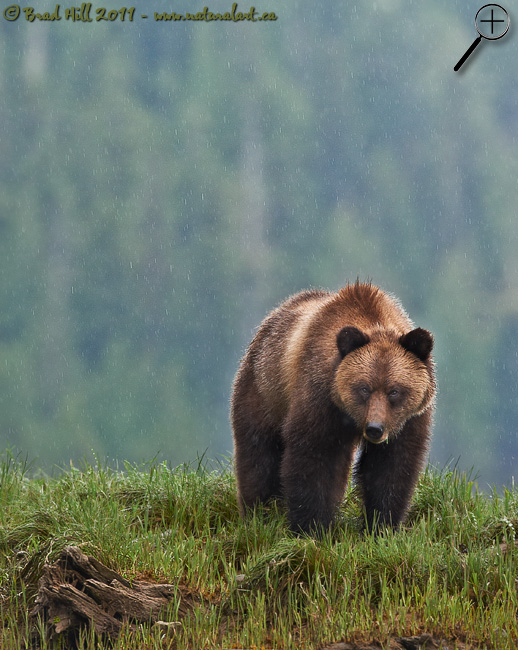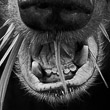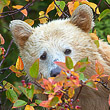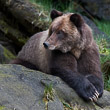Availability: Undetermined - Enquiries?
In the Field
Simple. And Simply Soaked! Khutzeymateen Inlet (Great Bear Rainforest), BC, Canada. May 26, 2011.
I often have a debate with myself over whether I should go to new regions and pursue new subject matter or return to the same locations and subjects and challenge myself to find a new way to portray the "same old" subject matter (tho' I have a real hard time thinking of photographing grizzlies in the Khutzeymateen as shooting the "same old" subjects!). When I ventured into the Khutzeymateen in the spring of 2011 I went in thinking "use negative space more" and "shoot more verticals" (and...yes...some cover shots for some specific publications WAS driving this thinking). My goal was to shoot verticals with a strong use of negative space that could stand alone AND work well with copy (text) overlaid on the image. It was a tough balance to strike, but definitely an interesting challenge!
Overlaying this goal of capturing "vertical negative space" images was my own preference for simple images with a minimal number of elements. And, of course, my predilection for moody images shot in anything but bright direct sunlight is hardly a secret! Of all the images I shot in the Khutzeymateen in spring 2011 (about 6,000 shots over 9 days) this one likely fits my "vertical, negative space, good for a cover or alone, simple, and moody" checklist the best (tho' I do have a few others that would challenge it). Interestingly, to me the image also pretty accurately matches the image I conjure up in my mind's eye when I think Khutzeymateen.
This image nicely illustrates a technical point about portraying rain in an image (and the rain is best seen in the larger image). I find that making rain drops show in an image is mostly a function of image processing, not image capture. This image was shot at a moderate shutter speed (1/250s) - which was driven largely by the need to have a speed high enough for me to hand-hold a pretty chunky lens (a 400mm f2.8 telephoto). I could have used anywhere from about 1/60s to up to about 1/400s and still had sufficient "streaking" in the drops to make them appear as rain. But, until I took two specific steps during image processing the rain drops were pretty much invisible (especially at the smallish sizes the images are shown here). The "tricks"? First, I locally enhanced the contrast in the background to slightly lighten the whitish rain and slightly darken the background forest. Second, I selectively ran a heavy but low pixel-radius sharpening (300% at 0.1 pixels in Photoshop CS5) on the background to help the drops stand out just a little more. A subtle thing, but an important thing...
NOTE: This image was captured in a region of British Columbia known as "The Great Bear Rainforest". I offer both instructional photo tours and "photo op only" photo tours into the Great Bear Rainforest each spring and autumn. If you're interested in more information about one of these tours, details are available on the Photo Tours page of this website!
Behind the Camera
Simple. And Simply Soaked! Khutzeymateen Inlet (Great Bear Rainforest), BC, Canada. May 26, 2011.
Digital Capture; RAW 14-bit format; ISO 450.
Nikon D3s with Nikkor 400mm f2.8 VR lens. Hand-held from floating Zodiac inflatable boat (VR on and in normal mode).
1/250s @ f4.5; no compensation from matrix-metered exposure setting.
At the Computer
Simple. And Simply Soaked! Khutzeymateen Inlet (Great Bear Rainforest), BC, Canada. May 26, 2011.
RAW Conversion to 16-bit TIFF, including first-pass/capture sharpening using Phase One's Capture One Pro 6. Three raw conversions varying in exposure settings over a 1.0 stop range - from -0.5 stops to darken the background slightly thru to +0.5 stops for shaded portions of the bear (shadow detail recovery).
Further digital corrections on 16-bit TIFF file using Adobe's Photoshop CS5 and LightCraft's Lightzone. Photoshop adjustments including blending of 3 exposure versions, selective exposure and tone curve adjustment, selective colour saturation and desaturation, and final sharpening for web output. Final tonemapping and contrast/tone tweaking - especially to midtones - performed with LightZone using the tonemapper/re-light tool.
Conservation
Simple. And Simply Soaked! Khutzeymateen Inlet (Great Bear Rainforest), BC, Canada. May 26, 2011.
Ten percent of the revenue generated by this image will be donated to Raincoast*.
Species Status in Canada**: Special Concern (May 2002).
While Grizzly Bears (Ursus arctos) are not technically listed as "Endangered" in Canada, they have been extirpated from most of their historical range. Grizzly Bears are far more sensitive to intrusion/disturbance in their habitat than are Black Bears and are being increasingly forced into marginal habitat by human encroachment. The Great Bear Rainforest along the central and northern coast of British Columbia is one of the last strongholds of the Grizzly Bear in Canada, and even this population is coming under increasing pressure.
On December 18, 2017 the government of British Columbia banned grizzly hunting across the entire province. This major conservation victory came after decades of tireless work by many dedicated conservationists and ecologists and, most importantly, it reflects the opinion of the vast majority of British Columbians. And, it means that AT LEAST while the current government remains in power grizzlies are finally "safe" in British Columbia.
Now that we've at least temporarily won the battle to save grizzlies in BC, it's time to re-focus our efforts toward protecting ALL of BC's carnivores, including Gray Wolves, Black Bears, Cougars, Wolverines, and more! Simply put, there are no ecological, economic, or ethical arguments supporting the trophy hunting of carnivores.
In a great first step towards ending the hunting of carnivores throughout BC the Raincoast Conservation Foundation has developed a program designed to protect ALL carnivores within the Great Bear Rainforest. Details about this program can be found on this page on Raincoast's website. Check it out and, better yet, make a donation to help Raincoast purchase the remaining commercial hunting tenures in the Great Bear!
*The Raincoast Conservation Society (and Foundation) is an effective and efficient organization that has been fighting for protection of this unique habitat. If you are looking for a meaningful way to contribute to the conservation of this amazing ecosystem, Raincoast will provide maximal "bang" for your conservation dollars.
**as determined by COSEWIC: The Committee on the Status of Endangered Wildlife in Canada

























